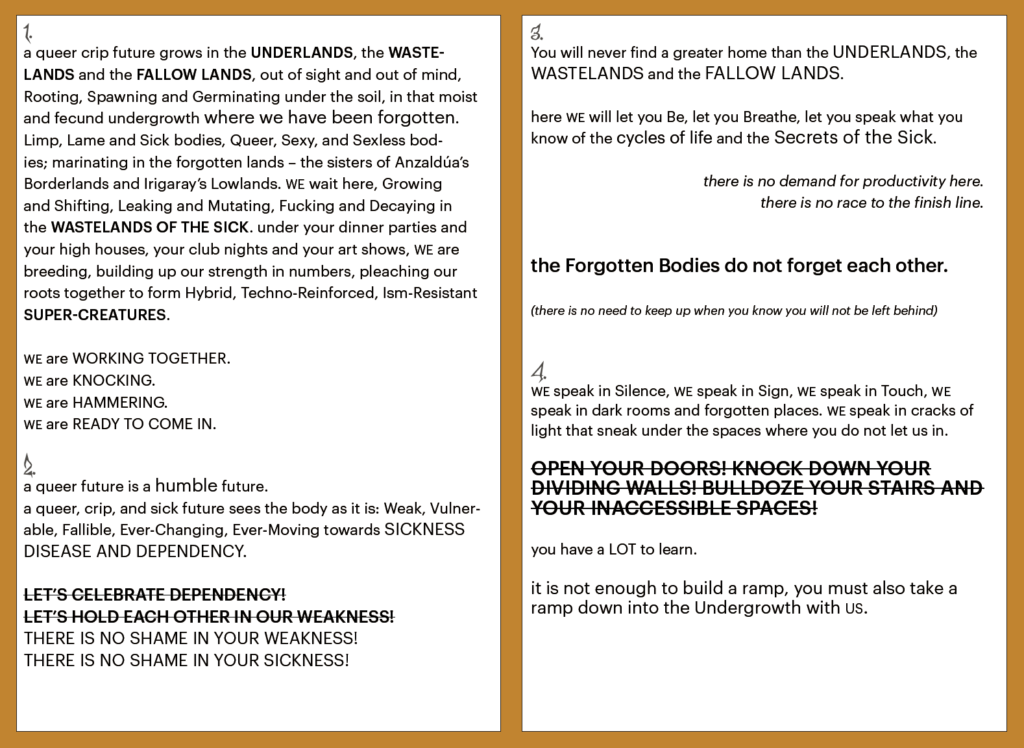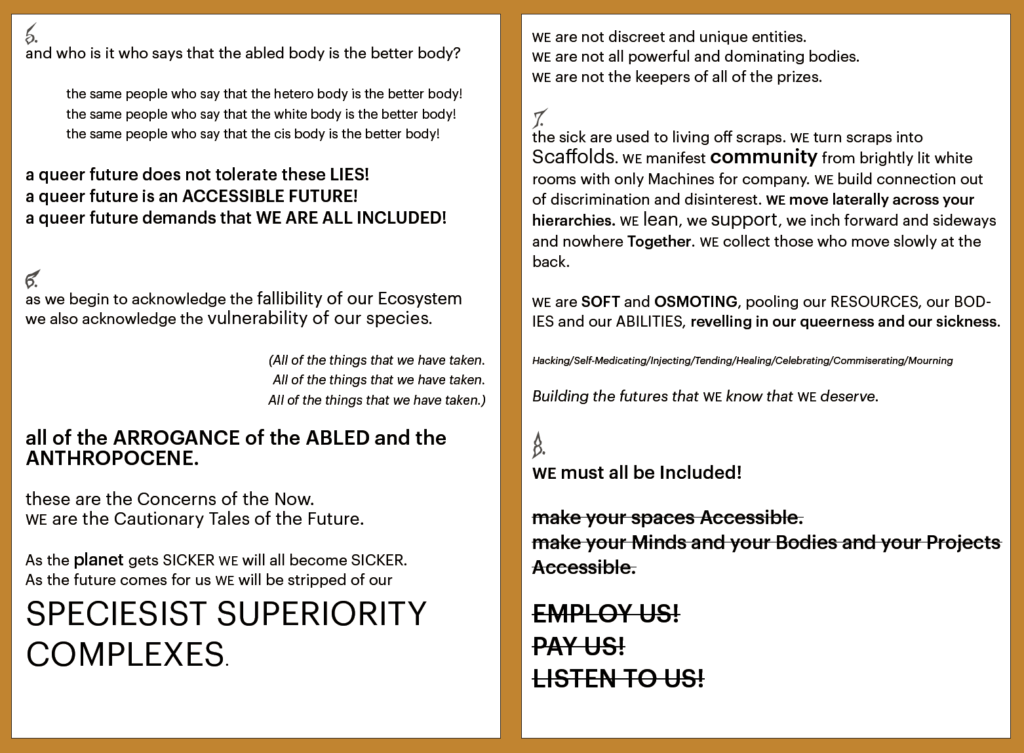by David Loner and Maggie Rosenau, 27 July 2020
In this post we want to share some thoughts on how and why the disabled community is suddenly receiving greater attention. We would like, in specific, to talk about the value of disabled knowledge, and how the story of disability justice connects to two separate however interrelated events happening now: the COVID-19 pandemic and the Black Lives Matter uprisings. By sharing sources that amplify disabled voices and collectives doing important social justice work, we hope to encourage involvement as we navigate together through these uncertain times.
The effects of COVID-19 are devastating. As the number of cases continues to grow at an alarming rate, several of the developed world’s governments have chosen to default on their responsibility to safeguard their citizens. Gross and intentional mismanagement of the pandemic in countries like the United States, the United Kingdom, and Brazil have resulted in mass outbreak, unemployment, and death, all leading to dramatic economic downturn and a world-wide recession which threatens to undo the alleged benefits of the neoliberal order outright. More than this, the already debilitating effects of a corrupt and predatory insurance-based “healthcare” system in the US have been accelerated, leading to the confirmed infection of an estimated 4 million individuals and the death of some one hundred and forty five thousand (Worldometer).
The Center for Disease Control and Prevention (CDC) reports that “long-standing systemic health and social inequities have put members of racial and ethnic minority groups at increased risk of getting COVID-19 or experiencing severe illness, regardless of age” (CDC Website). Because structural conditions inform pre-existing health issues, Black and brown communities have been disproportionately affected by the pandemic. To be sure, the recent BLM uprisings are not coincidental to the issue of COVID-19. Rather, they are part of the same story: the end-effect of state-coordinated violence and racism, instigated at the behest of capitalist excess and exploitation.
In the midst of these global events, greater attention is being paid to the disabled community. This is, in part, because everyday, middle-class, able-bodied/minded white people are themselves beginning to experience, perhaps for the first time, the debilitating effects of social inequity and impairment. Only a few examples need be given: the isolation of lock-down and social distancing, sudden passing of family and friends, job loss—and with it, the loss of health insurance, fiscal precarity, plus now housing insecurity. Despite this precarity, race plus bodymind capacity is not yet a factor for many of these individuals. Caring about other people continues to be a uniquely polarizing political issue for many in the US. At the same time, the old refrain ‘give me liberty or give me death’ has become entirely outmoded by the fact that for many the absence of social-democratic statecraft is a prescription for death. As the crisis deepens, a broad narrative is beginning to form around the reality that neoliberalism commodifies individuals based on metrics of production—ultimately discarding what life is left after it has successfully expropriated our bodyminds for short-term wealth accumulation.
Many of today’s most vocal and uncompromising figures in the disability justice movement are BIPOC and LGBTQ+ anti-capitalists. In their collective political action, these activists build on the legacy of those coalitions which first took root in the US during the civil rights movements of the late-1960s. Their story is one based not on free enterprise or personal liberty but instead community-oriented interest and initiatives, much of which speaks to the self-determination of Black and brown Americans, First Nation Peoples, queer people, and crucially, disabled people. Crip Camp, a 2019 film produced by Barack and Michelle Obama, tells the story of how the US disability movement of the late-twentieth century led to significant gains for persons with non-normative bodyminds. Through the political agitation of groups like Judith Heumann’s New York-based Disabled In Action (DIA), disability rights activists advocated for radical legislation and the toppling of ableist social policy, the worst of which had previously left thousands deprived of basic human rights in abusive asylums like New York’s Willowbrook. The crowning achievement of this movement was the Americans With Disabilities Act of 1990 (ADA), which this month celebrates its thirtieth anniversary. The ADA mandates equal access for abled and disabled citizens while also prohibiting discrimination against the disabled. This act was the result of decades of nonviolent protest, the most notable event being the 504 Sit-in at the San Francisco Health, Education and Welfare (HEW) headquarters in 1977. This saw the disabled community coalesce with members of the Black Panther Party and the San Francisco’s LGBTQ+ community, both who offered mutual aid to their brothers- and sisters-in-arms.
What is left unstated in this documentary is the dilemma that contemporary disability justice activists and theorists, including Mia Mingus, Alice Wong, Leah Lakshmi Piepzna-Samarasinha, Patricia Berne, Leroy Moore, Eli Clare, and the late Stacy Park Milburn, all believe is ever-present for the most marginalized: “the queer, trans, gender-nonconforming/noncompliant, undocumented, incarcerated, houseless, Black, brown, Indigenous, working-class, and working poor members for whom legal rights are inaccessible.” These writers prioritize structural analysis of societies of control and the biopolitical (including postcolonialism, queer theory, and anti-capitalism), contributing a new discourse which makes “interdepedency among multiple systems of dominion” its chief target of critique (Kim, 267). Their vision is one of community-based resource sharing practices and fair trade emotional economies, consciously organized by BIPOC, queer, crip and working-class communities as well as undocumented and houseless communities.
The overwhelming political power this vision offers in the absence of any competent elected representation or ostensive welfare state, as well as the continued onslaught cast against minority communities following four decades of neoliberal exploitation, is made all the more clear by life in the age of COVID-19. For those communities who are the target of the Trump Administration in its war against Black people, people of color, Indigenous people, and the Black Lives Matter uprisings—what is otherwise known in both centrist and conservative media as “Antifa”—making theory praxis can be a matter of life or death, not simply scholastic impact. We believe then that abdication of responsibility by state and federal leaders and policy-makers necessitates that we as scholars amplify the teachings of crip care collectives and anti-capitalist mutual aid in our work.
#StacyTaughtUs
How disability can save your life
Why disability justice?
When states of debility and disability are understood as ways of knowing, new possibilities for collective action can be recognized. “[O]ne thing that unites disabled people with those in other fluctuating states of debility,” notes curator Taraneh Fazeli, “is that their bodies are simply not as valuable to capitalism.” About 15% of the world’s population has some form of disability, making the disabled community the world’s largest minority (WHO). What is more, post-industrial practices (namely deforestation, which increases exposure to infectious diseases), together with deficiencies in healthcare services and an aging population, are causing rates of disability to increase. The number of individuals experiencing the deleterious effects of neoliberalism and white supremacy has risen substantially since the turn of the twenty-first century, bringing to light the inequities suffered by the abled and disabled alike. Undoubtedly, we have arrived at a new moment of class consciousness, reflective of those interabled approaches to “a thriving new world of interdependency” and political solidarity championed by disability scholars like Margrit Shildrick (601).
“a queer crip future grows…”


full manifesto
⇩
Notes From the Underlands
by Romily Alice Walden
Those potentially cohesive and ameliorative futurities elsewhere discussed by Alison Kafer (see Feminist, Crip, Queer, 2013) are now being actualized in the day-to-day political work of crip, queer, Black, brown, Indigenous, and trans communities amidst the global pandemic, the result of BIPOC and LGBTQ+ intersectional scholarship and activism and the BLM uprisings at large.
Here are a few ways to join the conversations about these crip futures happening now:
1. The Crip Camp Virtual Experience
(every Sunday, May–August 2020) is a series of online workshops hosted by grassroots activists and advocates, featuring speakers from the disabled community. Audience members are invited to join virtual After Parties and discuss. Recordings and transcripts are shared with those who are registered.
2. Twitter accounts and hashtags to follow:
|
@aaronphilipxo |
@Imani_Barbarin |
3. Webinars, Podcasts, Articles & More:
- Disability Justice & COVID-19
- Mapping Access Contra* Podcast
- Disability Visibility Project
- Changing the Framework: Disability Justice
- Disability Justice Curriculum
- Disability Social History Project
- Queer Futures Collective
- Online Teaching as Prosthesis?
- Rhetoric Society Quarterly, Special Issue: Disability, In/Visibility, and Risk (2020)
- Guidry-Grimes, Laura, et al. “Disability Rights as a Necessary Framework for Crisis Standards of Care and the Future of Health Care.” Hastings Center Report (2020).
Works Cited
“COVID-19 CORONAVIRUS PANDEMIC.” Worldometer (as of 22 July 2020).
“COVID-19 in Racial and Ethnic Minority Groups.” Center for Disease Control and Prevention, 25 June 2020.
“Disability and health.” World Health Organization, 16 January 2018.
Fazeli, Taraneh. “Notes for ‘Sick Time, Sleepy Time, Crip Time: Against Capitalism’s Temporal Bullying’ in Conversation with the Canaries.” Temporary Art Review, 26 May 2016, www.temporaryartreview.com.
Kafer, Alison. Feminist, Crip, Queer. Indiana University Press, 2013.
Kim, Jina B. “Disability in an Age of Fascism.” American Quarterly, vol. 72 no. 1, 2020, pp. 265–276. Project MUSE, doi:10.1353/aq.2020.0013.
Shildrick, Margrit. “Neoliberalism and Embodied Precarity: Some Crip Responses.” South Atlantic Quarterly, vol 118, no. 3. Duke University Press, 2019, pp. 595-613.
Walden, Romily Alice. “Notes from the Underlands.” Crip Magazine, vol. 3, 2019, pp. 10–13.
